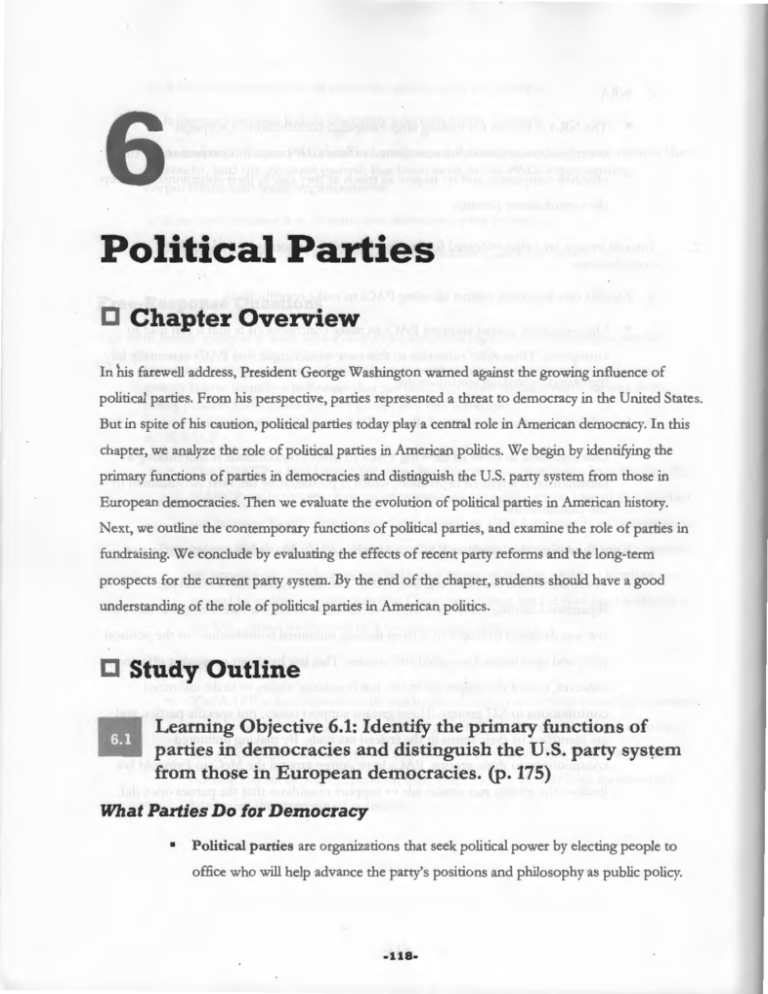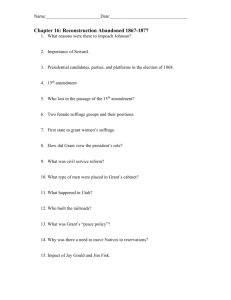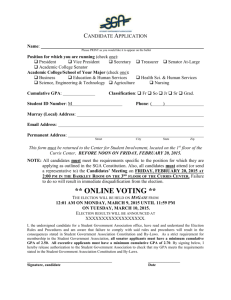Political Parties - Doral Academy Preparatory
advertisement

6 Political Parties [J Chapter Overview In his farewell address, President George Washington warned against the growing influence of political parties. From his perspective, parties represented a threat to democracy in the United States. But in spite of his caution, political parties today play a central role in American democracy. In this chapter, we analyze the role of political parties in American politics. We begin by identifying the primary functions of parties in democracies and distinguish the U.S. party system from those in E uropean democracies. Then we evaluate the evolution of political parties in American history. Next, we outline the contemporary functions of political parties, and examine the role of parties in fundraising. We conclude by evaluating the effects of recent party reforms and the long-term prospects for the current party system. By the end of the chapter, students should have a good understanding of the role of political parties in American politics. [J Study Outline II Learning Objective 6.1: Identify the primary functions of parties in democracies and distinguish the U.S. party sys~em from those in European democracies. (p. 17 5) What Parties Do for Democracy • Political parties are organizations that seek political power by electing people to office who will help advance the party's positions and philosophy as public policy. -118- • Nonpartisan election is an election in which candidates are not selected or endorsed by political parties and party affiliation is not listed on ballots. • Patronage is the dispensing of government jobs to persons who belong to the winning political party. • Parties organize the competition, unify the electorate, translate preferences into policy, and provide loyal opposition. • The period at the beginning of a new president's term during which he enjoys generally positive relations with the press and Congress is known as the honeymoon. The Nomination of Candidates • • Party candidates can be nominated in one of the following ways: Caucus is a meeting of local party members to choose party officials or candidates for public office and to decide the party platform. • Party convention is a meeting of party delegates to vote on matters of policy and, in some cases, to select party candidates for public office. • • • A direct primary is an election in which voters choose party nominees . An open primary is an election in which any voter, regardless of party, may vote . A closed primary is an election in which only persons registered in the party holding the primary may vote. • Crossover voting is voting by a member of one party for a candidate of another party. Party Systems • • The U.S has a two-party system with many minor parties . A minor party is a small political party that persists over time, is often composed of ideologies on the right or left, or that is centered on a charismatic candidate. • • Such a party is called a third party. Multiparty systems are found in countries that have a parliamentary government. o They usually have a head of state, often called the president, but also a head of the government, often called the prime minister. o With this system, coalition governments are necessary to rule. -119- • Proportional representation is an election system in which each party running receives the proportion of legislative seats corresponding to its proportion of the vote. • A winner-take-all system is an election system in which the candidate with the most votes wins. Minor Parties: Persistence and Frustration • Third parties occasionally arise to challenge the two major parties, but they rarely gain enough support to put a candidate in office. o Some parties form around a specific cause. o Some are splinter parties, formed from smaller factions of the two major partie: o Some form around a specific individual. o Though they rarely win, third-party candidates do force particular issues into t1 political debate and allow Americans to express their discontent with the two major parties. II Learning Objective 6.2: Describe changes in American political parties and identify four realigning elections. (p. 182 A Brief History of American Political Parties • Most democratic nations have multiparty systems that allow many interests to be represented. • The United States, however, has always had a two-party system . • Political scientists divide Ameri~an history into party eras, in which one party dominated politics for a significant period of time. • Party eras change when a critical election reveals new issues and a failure of the traditional coalitions. • This usually causes party realignment, when the party redefines itself and attraa new coalition of voters. The First Party System: 1796-1824 • Alexander Hamilton's short-lived Federalist Party was the first political party. -120- • Jefferson's Democratic-Republicans maintained control of the White House . The Democrats and the Whigs: 1828-1856 • Andrew Jackson appealed to the masses rather than to the elite, and he formed a new coalition and, ultimately, the Democratic Party. • The opposition party was the Whig Party, though it had little political success . The Two Republican Eras: 1860-1928 • The Republican Party formed out of a coalition of antislavery groups and nominated Abraham Lincoln as its flrst presidential candidate. • The election of 1896 began another strongly Republican era, during which industrialization and capitalism were advanced. The New Deal Coalition: 1932-1964 • Franklin Roosevelt brought the Democratic Party back into favor by starting scores of federal programs to combat the Great Depression. • The new Democratic coalition brought together the poor, Southerners, African Americans, city dwellers, Catholics, and Jews. • Kennedy's New Frontier and Johnson's Great Society and War on Poverty continued the Democratic New Deal tradition. 1968-Present: Southern Realignment and the Era of Divided Party Government • The states in the South have realigned and are now strongholds of the Republican Party, but this has not always been true. • President Nixon was able to capture the South, which had previously been solidly Democratic. • When Nixon became president, it was the flrst time in the 20th century that there was a divided U.S. government. • This became a frequent election pattern for most presidents that followed him. • Divided government is governance divided between the parties, as when one holds the presidency and the other controls one or both houses of Congress. -121- Learning Objective 6.3: Evaluate the functions of parties as institutions, parties in government, and parties in the electorate. (p. 187) American Parties Today Parties as Institutions • Unlike the more formal parties of other countries, American political parties are fairly decentralized, with city, state, and national administrative bodies. • The supreme authority in both major parties is the national party convention, which is a national meeting of delegates elected in primaries, caucuses, or state conventions. • Members assemble once every four years to nominate candidates for president and vice president, ratify the party platform, elect officers, and adopt rules. • The party platform details general party-wide issue stances . Parties in Government • Members of Congress take their partisanship seriously since it determines if a party controls the House or the Senate. • In the executive branch, presidents select members of the staff and cabinet mostly from their own party. • In the judicial branch, partisan politics mean less, but are still a factor in appointment to judicial benches. Parties in the Electorate • Party registration is the act of declaring party affiliation; required by some states when one registers to vote. • • Party regulars place party first . Candidate activists are followers of a particular candidate, who see the party as the . means to elect their candidate. • Issue activists wish to push the parties in a particular direction on a single issue or narrow ranges of issues. • Many voters cast their ballots on the basis of party identification . -122- • For instance, people who consider themselves Democrats usually vote for Democratic candidates. • Party identification is declining, however. Party Identification • The trend in divided government has led many political scientists to believe that the party system has dealigned rather than realigned. • Party dealignment means that people are gradually moving away from both parties . Learning Objective 6.4: Explain party fundraising and expenditures, and assess their regulation. (p. 196) How Parties Raise and Spend Money • With the rise of soft money in recent elections, parties have had more resources to spend on campaigns. • In 2002, Congress passed the Bipartisan Campaign Reform Act (BCRA), which bans soft money, except for some narrowly defined and limited activities. • Soft money is money raised in unlimited amounts by political parties for partybuilding purposes. o Soft money is now largely illegal except for limited contributions to state or local parties for voter registration and get-out-the-vote efforts. o The parties adapted to BCRA by building a larger individual donor base. o Donors wanting to spend more than the BCRA limits did so in 2008 through a range of interest groups. o Many were allied to 527 groups that ran parallel campaigns with the candidates and parties. • Hard money involves political contributions given to a party, candidate, or interest group that are limited in amount and fully disclosed. Raising such limited funds was harder than raising unlimited soft money, hence the term "hard money." o The Supreme Court has ruled that individuals, groups, and parties can spend unlimited amounts in campaigns for or against candidates as long as they operate independendy from the candidates. -123- o When an individual or party does so, they are making an independent expenditure. II Learning Objective 6.5: Assess the effects of recent party platforms and the long-term prospects for the current party system. (p. 197) lire the Political Parties Dying? • Frequent efforts have been made to reform both political parties . • 'The Progressive movement saw parties, as then organized, as an impediment to democracy and pushed direct primaries as a means to reform them. • Following the 1968 election, the Democratic Party took the lead in pushing primaries and stressing greater diversity among the individuals elected as delegates. • Republicans have also encouraged broader participation and they have improved their party structure and fmances. • There has been some party renewal in recent years as party competition has grown in the South and the parties themselves have initiated reforms. For .Additional Review Design a pyramid diagram depicting the top-down leadership structure within a political party (national level, state level, local level). Place the various party members on the pyramid along with a description of the role played by each. Use this pyramid diagram when reviewing and studying for the unit test and the AP Government and Politics exam. Create a timeline depicting the evolution of political parties in the United States. Place the major eras of political party development on the timeline along with a description of each era, including the political parties, their platforms, and accomplishments. Use this timeline when reviewing and studying for the unit test and the AP Government and Politics exam. ·124·








